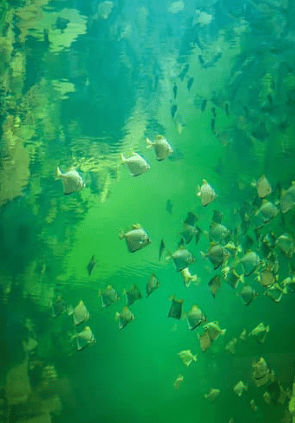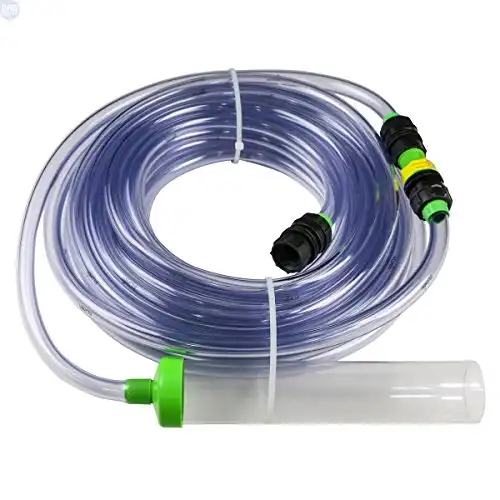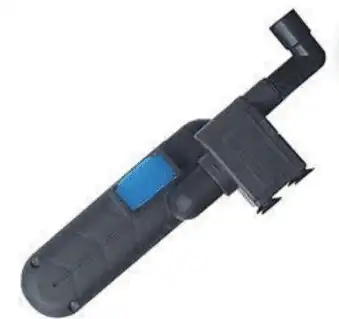Thank you for visiting! By the way… any links on this page that lead to products on Amazon and other stores/partners are affiliate links Aquarium Store Depot earns a commission if you make a purchase.
Imagine the crystal clear blue waters of the Caribbean teeming with life and color. Now place that against your murky, sea-monster-green home aquarium where you can only make out the shadows of fish. Something’s not right here.
Aquarium water shouldn’t be green. Freshwater or saltwater, aquarium water should be clear–with a slight sparkle if you have LED lights! Green aquarium water is ugly and can make it difficult to enjoy your fish, plants, and invertebrates. In severe cases, it can also start to affect the ability of your plants to photosynthesize.
Key Takeaways
- Green aquarium water is ugly but usually not harmful to aquatic life.
- The main causes behind green discoloration in a fish tank are lighting issues, overfeeding, overstocking, or poor aquarium maintenance.
- Greenish water can be cured by resolving these problems, installing additional equipment, or planting live plants in freshwater tanks and growing more corals/macroalgae in reef tanks.
Why Is Your Aquarium Water Green?
What causes aquarium water, and how do you fix it?
Green aquarium water is often caused by single-cell algae that free-swim in the water column. This planktonic algae is different from those you may find growing on glass or aquarium decorations but grows due to many of the same contributing factors.
It can be near impossible to tell exactly which type of single-cell algae you’re dealing with when you have green water1. Luckily, the specific species doesn’t matter too much. It is safe to assume that you are dealing with a kind of phytoplankton, most commonly dinoflagellates.
In order to make your water go from swampy green to crystal clear, you need to understand what’s causing the algae to grow.
Reasons Your Aquarium Water Is Green
Although a single-celled species, this algae growth is caused by the same factors that influence macroalgae growth. This includes lighting issues, overfeeding, overstocking, and overall poor tank maintenance.

1. Lighting Issues
Aquarium lighting is hard to get right but we’ve certainly come a long way from fluorescent light bulbs. Today, many aquarium lights give complete control to the user in terms of intensity, spectrum, and photoperiod. All of these parameters are customizable for the best plant and coral growth.
The problem is that algae growth hasn’t changed over the years. Algae still love light and will grow whenever and wherever they can when light is available.
Lighting can contribute to algae growth in several ways. The first way is intensity. High lighting intensity is needed for good plant and coral growth. However, if there is excessive light or the speed of organism growth doesn’t match the strength of the light, then algae can start to outcompete the other photo-dependent creatures in the tank. Sudden increases in light can also increase algae growth as plants need time to acclimate to stronger conditions.
Another way tank lighting affects green water is due to the spectrum emitted, or the different wavelengths of energy that are transmitted from the aquarium light to the photosynthetic parts of the plant or coral. The problem is that different photosynthetic species absorb different wavelengths of energy, meaning that plants and corals thrive under different spectrum settings from algae. It can take some trial and error to find the right tank light settings that allow for plant growth instead of algae growth.
Lastly, photoperiod can greatly influence the appearance of green aquarium water. A long photoperiod is one of the leading causes of green water along with excess nutrients, which we’ll talk about more later.
Photoperiods vary from tank to tank based on the aquatic plants and corals being kept. In general, hobbyists keep their tank lights on for anywhere between 7 to 10 hours. This gives enough time for plants to make and store food, which contributes to healthy growth.
However, plants can’t fulfill photosynthetic processes to their full extent for longer-than-normal periods. As a result, algae become opportunistic and outcompetes other photosynthetic organisms for the leftover available light energy.
Another important factor to keep in mind is that natural light will contribute to green aquarium water. This may be the result of a nearby window. Natural light has a very different spectrum from controllable tank lighting, allowing unwanted wavelengths to feed algae. Direct sunlight can also contribute to warming the tank, which further fuels green water algae.
2. Overfeeding
Most hobbyists are guilty of overfeeding their fish. The truth is that fish don’t need to eat that much food and a lot of it goes wasted. This excess is left to rot at the bottom of the tank until it is converted into nutrients or manually removed.
Another problem that comes along with overfeeding is the quality of the food. Many unknowing hobbyists pick foods that are inexpensive. Unfortunately, many of these foods have poor nutritional value with lots of filler ingredients. These filler ingredients don’t get completely digested by fish and are mixed back into the aquarium water; phosphate levels from these foods are especially likely to affect green water algae reproduction rates.
Leftover and uneaten food lead to excess nutrients that quickly cause green water algae to thrive.
3. Overstocking
Similarly, overstocking can also cause algae to bloom in your aquarium.

A surplus of fish and invertebrates means more waste that needs to be processed. In balanced aquariums, fish waste is effectively broken down and processed by beneficial bacteria. When there is too much waste available, bacteria are overwhelmed, and nutrients are left to accumulate in the form of ammonia, nitrite, and nitrate.
In extreme cases, high levels of ammonia can stop the nitrogen cycle from happening altogether. This is deadly to fish and a much bigger problem than unpleasant green aquarium water.
4. Poor Tank Maintenance
Free-floating algae bloom when there are imbalances within the aquarium. One of the main ways aquarium hobbyists keep their fish tanks running smoothly is by performing regular tank maintenance. This includes regular water changes, gravel vacuums, and filter upkeep.
The Python is a mainstay in the fish hobby. Easily clean your aquarium by connecting this to your sink!
This might sound like a lot of work, but minimal maintenance will ensure that you never experience green water in your freshwater or saltwater aquarium.
Most aquariums need to be cleaned once a week or once every other week. Some hobbyists get by with doing maintenance only once a month, but this can only be achieved once you know the ins and outs of your system. In general, a 10-25% water change is needed weekly or biweekly.
When performing a water change, it is important to know the water parameters of the new water that is added. Many freshwater hobbyists use tap water as it contains the necessary minerals needed for a healthy tank. Unfortunately, tap water also contains a lot of unknowns, which can unknowingly boost nitrate and phosphate levels, leading to unwanted free-floating algae.
If your tap water has poor water quality, then you will need to find another source. For the best control, marine hobbyists use RO/DI water that can then be customized to their preference.
During water changes, the substrate should be vacuumed. Food and waste accumulate on the bottom of the tank, which can lead to high nitrate and phosphate levels. Kicking up the substrate too much at once can also upset water parameters, so it’s important to only do one section at a time at first.
Every now and then, the filtration system should also be cleaned. Some hobbyists gently rinse their filter media weekly, but this can be done on a monthly basis; handling filtration media can disturb and damage beneficial bacteria, which could potentially lead to green water outbreaks.
Is This Harmful To Fish?
Green aquarium water looks bad. While it might seem like your fish is struggling to survive in a cloud of green, green water is generally harmless to fish.
Free-floating algae won’t kill your fish and many fish and invertebrates naturally live in green-colored ecosystems; you won’t see crystal-clear aquarium water in the wild!
However, free-floating algae bloom can cause oxygen levels to dip, which could potentially cause fish to suffocate. While algae perform photosynthesis and create oxygen in the process, algae respire when light is not present and create carbon dioxide in exchange. This buildup, in addition to the carbon dioxide produced by fish and invertebrates, can prove to be deadly in extreme cases.
It should also be noted that plants love light. In especially green water, they may struggle to receive enough light necessary to grow and live. Stunted plant growth means less nutrient uptake, which further contributes to the growth of the algae.
Big picture, green water in a fish tank is usually indicative of a greater underlying problem. These are the true problems that could potentially kill your fish. In general, this means severe imbalances in water quality.
Can This Ever Be Good for the Tank?
Yes! In fact, some hobbyists deliberately grow free-floating algae in their fish tanks to cultivate a natural ecosystem.
Algae is considered a primary producer, which means that it’s at the bottom of the food chain. Bacteria and other microorganisms use algae as food. These are then eaten by other organisms, including infusoria, which eventually become desirable food for small fish and fry.
How To Fix Your Tank Problem
It can be hard to tell when aquarium water is turning green. One day your fish tank is crystal clear, the next, it’s murky, and then you have a full-on green water problem. This transformation can happen in just a few days, so it’s important that you check on your aquarium daily.
Luckily, fixing a green algae problem is pretty straightforward once you’re able to identify the underlying problem: lighting issues, overfeeding, overstocking, or poor tank maintenance. A few other methods of treating green aquarium water are using additional equipment, chemical treatments, and adding live aquatic plants.
1. Resolving Lighting Issues
Aquarium light fixtures are the best they’ve ever been, but they only work their best when they’re calibrated for your individual system. This takes some trial and error, but a good light setting and schedule are crucial for maintaining and preventing green aquarium water.
If a green algae bloom has already taken hold of your fish tank, reassess how many hours your light is on. If you’re towards the bottom of the recommended 7 to 10-hour range, then check the intensity and spectrum. Recalibrate the light for the specific species you are growing. Failing lighting can also affect efficiency.
While you’re at it, check your tank’s surroundings. Ensure that there is no direct sunlight hitting the aquarium and that ambient lighting is kept to a minimum.
2. Limit Feedings
Overfeeding is easy to fix, though it may pull at some heartstrings–you do not need to feed your fish every time you walk past the tank!
Instead, invest in high-quality food that will be fully digested. At the same time, reduce portion sizes. If your fish are still hungry, feed them several smaller portions throughout the day.
Remove all uneaten food after 5 minutes.
3. Compensating For Overstocking
It happens. You get wrapped up in the excitement of buying fish that you take home a few too many. While this isn’t ideal, you need to give all your fish the best life possible.
If possible, rehome the fish. Some pet stores might take back the fish, but there are many online communities that can connect fellow hobbyists.
If rehoming the fish isn’t possible, then a larger filtration system may be installed. Additional filtration media will help compensate for the increased waste entering the system. Providing more water flow in the form of powerheads and air stones will also help keep debris from settling while facilitating gas exchange.
The Quietest Air Pump
Powerful, quiet, and German engineered. Even comes with an air stone! The best aquarium air pump you can buy today!
4. Achieving Perfect Water Parameters
The truth is those perfect water parameters don’t exist, and you should never change a healthy tank for one that looks good on paper. The most important part of tank parameters is having 0 ppm ammonia and 0 ppm nitrite, as these compounds can be deadly. Nitrate and phosphate levels should be kept to a minimum but are needed to facilitate a functioning system.
Water parameters can be maintained through regular tank maintenance and water changes with reliable source water. Debris and other organics should be removed weekly with an aquarium siphon to prevent nutrient buildup. Water parameters should then be tested weekly to ensure that balance and stability are achieved.
5. Additional Equipment
It usually isn’t necessary to purchase additional equipment to deal with a green algae problem, but there are some added benefits to installing new equipment. One of the best pieces of equipment you can purchase to combat greenish water is an ultraviolet (UV) sterilizer.
UV sterilizers polish water. This device uses UV light to penetrate DNA, RNA, and proteins to destroy most pathogens, viruses, bacteria, and algae. UV sterilizers are very commonly used in pond settings that are susceptible to algal blooms and infestations. In the aquarium, UV sterilizers can be very helpful for combatting small issues concerning diseases and suspended algae in the water column.
Budget Option
A great way to get clarification level UV sterilization for a great price. Very effective against green water
The problem is that UV sterilizers are not the cheapest pieces of aquarium equipment. Quality ones retail for at least $100, with prices increasing depending on the size required. The UV light also needs to be regularly replaced. It’s important to keep in mind that a UV sterilizer will also take up valuable space in the aquarium display or in external filtration.
6. Chemical Treatment
Chemical treatment is not recommended for treating a green algae problem. Chemicals simply cover up the problem and don’t address it as its root.
The only chemicals we recommend are those that bolster the fish’s immunity and overall fish tank health during stressful periods.
7. Add Live Plants
Instead of harsh, difficult-to-dose chemicals, simply add live plants to your tank. For reef tanks, add easy-to-keep corals or macroalgae; a refugium can also help to export excess nutrients.
Live plants provide a plethora of benefits to the freshwater aquarium. Not only will aquatic plants help tackle green algae problems, but they’ll continue to feed the system with fresh oxygen, food, and shelter.
If you’ve never kept a planted tank before, the initial thought of it can be scary. It is true that most plants require a better-than-average aquarium light, but LED lights are very affordable and low maintenance. If you can’t take that plunge right now, floating plants and other low-maintenance species can easily be kept under lower light settings.
Current USA's offering into aquascaping is an incredible value. Spectrum, spread, easy to program and great PAR output.
No matter which species of plant you decide to go with, aquarium plants will help correct a green water problem and keep the tank healthy.
Final Thoughts
A fish tank can turn green in just a few days. While this sudden change is definitely a cause for concern, the algae that cause the discoloration is unlikely to harm fish or invertebrates. However, there is some threat to aquatic life if excess nutrients are the underlying problem.
Green aquarium water is mostly caused by lighting issues, overfeeding, overstocking, and poor tank maintenance. The hardest part of correcting a green water problem is identifying the root of the problem. Luckily, the discoloration can be fixed by resolving those issues or by adding additional equipment or live plants.
- About the Author
- Latest Posts
I’m thrilled that you found Aquarium Store Depot! Here you’ll find information on fish, aquariums, and all things aquatics related. I’m a hobbyist (being doing this since I was 11) and here to help other hobbyists thrive with their aquariums! I adhere to a high quality Editorial Process and Review products with real life field usage and practical analysis.











I’ve right now a 55g tank and it’s way more over stocked than it should be. I’ve plenty of live plants too. I have not yet started using fertilizer and my plants growing in pots , as substrate I’ve pebbles between 1-2 inches . This setup is running for around 2 years and still now I have had no issues with algae bloom or green water . Only one side of wall has algae and idk why my mollies do not eat from that side . I’ve not changed water for last 4 months although I’ve checked the values . I only refill what’s lost due to evaporation. I’m thinking now to add some macro and micro fertilizer. I let light on for 10-11 hr every day . My plants aren’t growing much , but I’m afraid of adding nutrients from outside might lead to algea bloom . I’m still trying to decide what to do as my plants clearly need more nutrients.
When was the last time you tested your parameters (nitrate, phosphate)? I would look at that first. You could also try some nerite snails or Octos to help out.